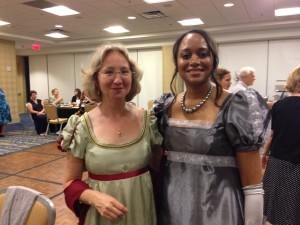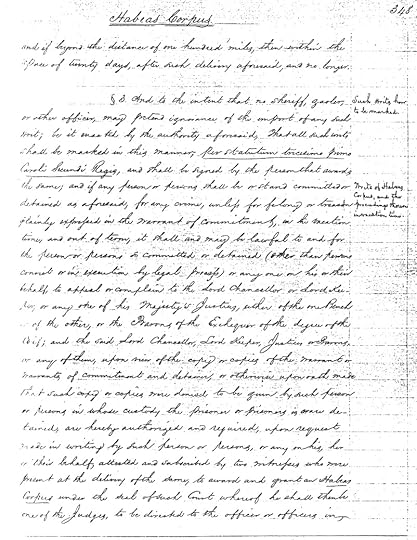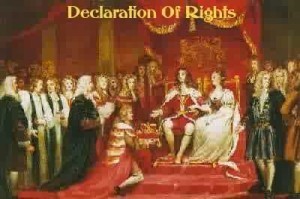Vanessa Riley's Blog, page 94
July 3, 2024
The Publishing of Pride and Prejudice and a Chance to Win
The below article contains information and excerpts pulled from Kathryn Kane’s article on the 200th anniversary of Pride and Prejudice from her blog, The Regency Redingote.
Wendnesday, Laurie Alice shared about Jane’s long and laborious road to publishing and her subsequent career. Today we look at the publishing of Pride and Prejudice.
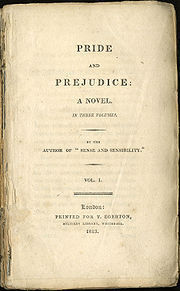 Originally titled First Impressions, the story of Elizabeth, Darcy, and their families and friends was originally written as a collection of letters. This epistolary style of novel was familiar to Jane as she had already written one as a teenager and one of her favorite authors wrote in that style as well. Obviously, she adjusted the format as well as the title prior to publication.
Originally titled First Impressions, the story of Elizabeth, Darcy, and their families and friends was originally written as a collection of letters. This epistolary style of novel was familiar to Jane as she had already written one as a teenager and one of her favorite authors wrote in that style as well. Obviously, she adjusted the format as well as the title prior to publication.
Pride and Prejudice was Austen’s second novel and it was instantly popular. The first print run of 1500 copies sold out even before the first run of Sense and Sensibility, which was half the size. Demand was so high that in October of 1813, her publisher, Thomas Egerton, released a second print run of Pride and Prejudice. A third printing was done shortly after her death.
Despite the popularity of the novel, Jane made only £110. Far less than the more than £450 her publisher made. Due to the slow sales of Sense and Sensibility at the time, she sold the rights to Pride and Prejudice for a lump sum.
Even though Pride and Prejudice was well loved by the public, Jane felt a little differently. Shortly after Pride and Prejudice was published, Jane wrote to her sister, Cassandra:
Upon the whole … I am well satisfied enough. The work is rather too light, and bright, and sparkling; it wants shade; it wants to be stretched out here and there with a long chapter of sense, if it could be had; if not, of solemn specious nonsense, about something unconnected with the story: an essay on writing, a critique on Walter Scott, or the history of Buonaparté, or anything that would form a contrast and bring the reader with increased delight to the playfulness and general epigrammatism of the general style.
It may very well be the fact that it was ” … light, and bright, and sparkling … ” which made it so popular.
In 1813, England was involved in wars on two fronts, for both the Peninsular War and the War of 1812 were ongoing. People were weary of war and the privations which it brought. Pride and Prejudice gave them an amusing respite in the peaceful and traditional English countryside, which many valued highly as the epitome of the English way of life. A countryside and way of life which many realized was already under threat from the relentless progress of the Industrial Revolution.
Jane’s fictional village of Meryton was populated by a host of amusing characters involved in the activities of everyday life and her witty tale included a pair of love stories that ended happily ever after.
To read more about the writing and publication of Pride and Prejudice, see Kathryn Kane’s original article.
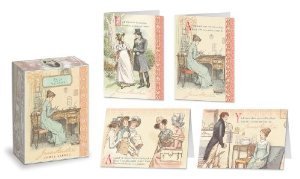 This week we’re giving away a lovely set of Jane Austen notecards. For a chance to win, please leave a comment on any of the posts this week. winner will be drawn Monday, August 12. Winner must have a mailing address within the United States.
This week we’re giving away a lovely set of Jane Austen notecards. For a chance to win, please leave a comment on any of the posts this week. winner will be drawn Monday, August 12. Winner must have a mailing address within the United States.
Originally posted 2013-08-09 10:00:00.
The post The Publishing of Pride and Prejudice and a Chance to Win first appeared on Vanessa Riley's Regency Reflections.
Jane Austen’s Road to Publishing and A Chance to Win
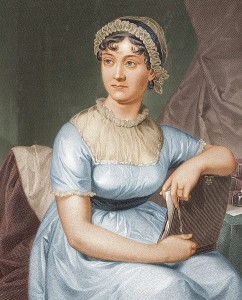 Jane Austen
Jane AustenWhen one mentions Jane Austen, the majority of people think Pride and Prejudice and the movies, not necessarily the book, who’s bicentennial of it’s publication we are celebrating this month. Miss Austen, however, wrote several other works, including an epistolary novel in the 1790s. Like the majority of authors nowadays, Austen faced rejection and publishers who did not fulfill their promises.
One of Austen’s biographers, Claire Tomalin, writes of Lady Susan, “in letters, it is as neatly plotted as a play, and as cynical in tone as any of the most outrageous of the Restoration dramatists who may have provided some of her inspiration … It stands alone in Austen’s work as a study of an adult woman whose intelligence and force of character are greater than those of anyone she encounters.” This is impressive when one considers she was less than twenty years old.
In 1811, Sense and Sensibility was published, though she probably began it much earlier. We don’t know if the original story known as Elinor and Marianne, which she read to her family in the 1790s, survived in this novel.
Still in the 1790s, Austen attempted a third novel, which was a satire of the popular Gothic novel. That manuscript, which we know as Northanger Abbey, ended up the first one for which she received any money.
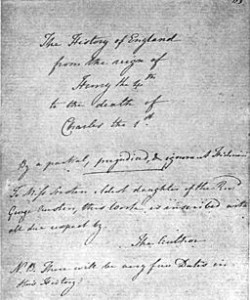 One of Austen’s early works, The History of England. Photo by wikimedia commons
One of Austen’s early works, The History of England. Photo by wikimedia commonsHer father attempted to get her published, but that manuscript, First Impressions, later published as Pride and Prejudice, was rejected. But in 1803, a London publisher paid Austen ten pounds for the copyright on Northanger Abbey. It was not published until Austen bought back the copyright more than ten years later.
After the family moved to Bath, she may have suffered from a depression that kept her from writing, or she may have revised her already created works. We aren’t certain. We do know she worked on The Watsons, but never finished it after her father died. Her own situation as an unmarried woman without independent means, closely reflected the ladies in the story.
Finally, in 1811, Sense and Sensibility was published and well-received, nearly twenty years after we believe she began work on her first novel. Pride and Prejudice was published in 1813, which we are celebrating this month as it is her most famous work today.
Mansfield Park was her best selling novel and published in 1814. Reviewers ignored it, but the public did not.
Although the books were published anonymously, and I’ve always been told that no one knew who wrote the books, I scarcely think this is true, at least for those able to worm information from perhaps the publisher, as the Prince Regent’s librarian invited her to visit and she was given the suggestion that she dedicate Emma to him in 1815. She didn’t like him, but she couldn’t refuse. This was her last book published during her lifetime.
After her death, Persuasion and Northanger Abbey were published as a set in 1817. Sanditon was published, though unfinished, in 1825. Her books remained out of print until a set of her works were published in 1833. They have been in print ever since.
 This week we’re giving away a lovely set of Jane Austen notecards. For a chance to win, please leave a comment on any of the posts this week. winner will be drawn Monday, August 12. Winner must have a mailing address within the United States.
This week we’re giving away a lovely set of Jane Austen notecards. For a chance to win, please leave a comment on any of the posts this week. winner will be drawn Monday, August 12. Winner must have a mailing address within the United States.
Originally posted 2013-08-07 10:00:00.
The post Jane Austen’s Road to Publishing and A Chance to Win first appeared on Vanessa Riley's Regency Reflections.
July 2, 2024
Gone Too Soon, Jane Austen
Vanessa here,
“It is a truth universally acknowledged, that a single man in possession of a good fortune, must be in want of a wife.”
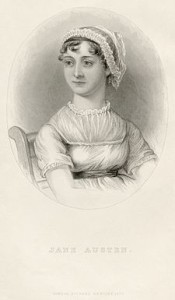 Jane Austen
Jane AustenSo begins the words to the novel, Pride and Prejudice, and with it the love affair we have for 1800’s England. Now many of us may have been introduced to Jane Austen because of a high school literature assignment or catching a BBC or a Hollywood version of one of her books. I have come to know and appreciate her talents for unlike me, she was a contemporary author writing of her times, of the societal norms and taboos. Austen excelled at capturing the mood of the classes and the roles of women. Her words allow us to visit that time and space we lovingly call the Regency.
So today, I’d like to spend a few moments highlighting the amazing woman, Jane Austen.
Her BirthBorn December 16th, 1775, Jane Austen was the second daughter, the seventh child of eight for Reverend George Austen and Cassandra Austen. They lived in Steventon, Hampshire. They weren’t a rich family at £ 600 per annum. So Jane would find herself very much like her character, Elizabeth Bennett, with nothing more than her charms to recommend her.
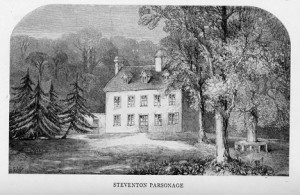 Jane’s Father’s Church, Her HomeHer Education
Jane’s Father’s Church, Her HomeHer EducationShe learned as most girls did at home, to draw, play the piano, and the running of a household. From 1785 to 1786, she and her sister, Cassandra were sent to an aunt in Oxford for more studies. They were later sent to the Abby Boarding School in Reading.
Her Love of a Good BookBy 1801, Jane’s father possessed a large book collection of over 500 books. She is described by family members as a great reader. Her favorites included Fanny Burney’s Cecilia and Camillia and Samuel Richardon’s Sir Charles Grandison, and Maria Edeworth’s Belinda.
In Jane’s Northanger Abby, she puts up a defense of the reading and novels:
“There seems almost a general wish of decrying the capacity and undervaluing the labour of the novelist, and of slighting the performances which have only genius, wit, and taste to recommend them… In short, only some work in which the greatest powers of the mind are displayed, in which the most thorough knowledge of human nature, the happiest delineation of its varieties, the liveliest effusions of wit and humour, are conveyed to the world in the best-chosen language.”
Her Love LifeFrom her letters, one can see a few men came a courtin’ but she found most wanting: Heartley, Powlett, Lefroy.
In one of her correspondences, she writes:
“Tell Mary that I make over Mr. Heartley and all his estate to her for her sole use and benefit in future, and not only him, but all my other admirers into the bargain wherever she can find them, even the kiss which C. Powlett wanted to give me, as I mean to confine myself in future to Mr. Tom Lefroy, for whom I do not care sixpence. Assure her also, as a last and indisputable proof of Warren’s indifference to me, that he actually drew that gentleman’s picture for me, and delivered it to me without a sigh.”
Then later we find this:
“At length the day is come on which I am to flirt my last with Tom Lefroy, and when you receive this it will be over. My tears flow at the melancholy idea.”
And with the end of things with Mr. Lefroy, Jane’s friend (Mrs. Anne Lefroy, cousin to Tom Lefroy) even tried to play match maker. Mrs. Lefroy tried to fix Jane Austen up with the Rev. Samuel Blackall, a Fellow of Emmanuel College. It didn’t work out (See our take on Blackall). Perhaps her joy of writing claimed all her love. Or was she too poor to make a man fall violently in love with her.
Her WritingJane started her writing “career” with short stories. These pieces varied from witty to satirical. Many of these short stories were collected together and called the Juvenilia. Over 20 different shorts fill this collection with the most famous being: The Beautiful Cassandra, Love and Friendship, and The History of England.
Her published works (the ones published during her lifetime or posthumously by family members are included below: (S=Synopsis, W=Link to the Whole Work. Go ahead and download a copy provided for free.)
Sense and Sensibility (1811) S WPride and Prejudice (1813) S WMansfield Park (1814) S WEmma (1815) S W Northanger Abbey (1817) S WPersuasion by Jane Austen (1817) S W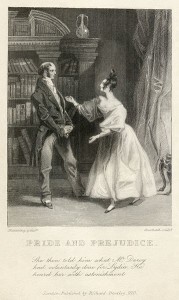 Pride and PrejudiceHer Death
Pride and PrejudiceHer DeathJane Austen died in 1817 at the age of 41. She began to get ill in 1816 and the yearlong decline, tapped her energy and made her in the end bed-ridden. The cause of her death is disputed. Some venture it was lymphoma. Others Addison’s disease. Another view is she died from bovine tuberculosis contracted by drinking unpasteurized milk. As I check the label, on the milk cartoon for my coffee, I’ll add a final potential cause, typhus, a recurrent form of the disease developed from a childhood illness. Her death left two more manuscripts unfinished, Sanditon (1817) and The Watsons (1804). She is buried at Winchester Cathedral in Winchester, Hampshire.
 Winchester Cathedral
Winchester CathedralWell, I think we should all agree, her life was too short. Nonetheless, judging by the longevity of her work, she may just have accomplished what she was born to do. Share with us a favorite Jane Austen line or scene and why it sticks with you.
References:
Images are from Wikipedia/Wiki commons.WikipediaProject GutenbergPemberly.comThis week we’re giving away a lovely set of Jane Austen note cards.
 Win This Prize.
Win This Prize.For a chance to win, please leave a comment on any of the posts this week. winner will be drawn Monday, August 12. Winner must have a mailing address within the United States.
Originally posted 2013-08-05 10:00:00.
The post Gone Too Soon, Jane Austen first appeared on Vanessa Riley's Regency Reflections.
Happy Anniversary, Pride and Prejudice!
 Two centuries ago, a book was published that would impact the world of romantic literature forever. This year marks the two hundredth anniversary of Jane Austen’s Pride and Prejudice.
Two centuries ago, a book was published that would impact the world of romantic literature forever. This year marks the two hundredth anniversary of Jane Austen’s Pride and Prejudice.
You don’t have to be a fan of Jane Austen, a lover of Mr. Darcy, or kindred spirit to Elizabeth Bennet to see the impact this book has had on modern culture and literature, particularly the Regency romance.
All this month, we will be looking at the different aspects of Austen’s book, her life, and her legacy. Do you have a favorite character? Movie adaptation? Modernization? Maybe you’re an avid reader of the many Austen spin off novels. Perhaps the main fascination Austen and her best-selling book have for you is the lasting legacy they have inspired.
 Jane Austen
Jane AustenWe’re going to look at all of these things through the month of August. And, as always, it wouldn’t be complete without you entering in on the discussions.
As if a lively discussion about Pride and Prejudice wasn’t enough to get you excited, we’ll be giving away a Jane Austen or P&P themed gift every week. Participate in one of that week’s three post discussions and you’ll be entered to win. It’s that simple.
So let the celebration begin!
No prize will be rewarded today, but we’d love to hear about the first time you remember reading Pride and Prejudice. Did you love it? Hate it? Absorb it until it’s such a part of your being that you dream of transporting through the shower and taking Elizabeth Bennet’s place… oh wait. That’s Lost in Austen.
Originally posted 2013-08-02 10:00:00.
The post Happy Anniversary, Pride and Prejudice! first appeared on Vanessa Riley's Regency Reflections.
July 1, 2024
William Wilberforce: Abolitionist and Friend, Politician and Evangelical
“If this be madness, I hope that it will bite us all!” said one of William Wilberforce’s friends after the young politician became an evangelical Christian. His other friends thought his newfound beliefs and life changes madness, and they still counted him friend and so much more.
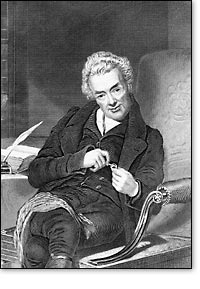 William Wilberforce
William WilberforceBorn in 1759, William was a sickly young man with poor eyesight, slight stature, and a quick mind. He sang and conversed in ways that pleased his interlocutors to the point the writer and socialite Madame de Staël described him as the “wittiest man in England”. And the Prince of Wales said he would go anywhere to hear Wilberforce sing.
Wilberforce was born to a wealthy merchant family. After his father died when the lad was young, he went to live with an uncle. But other relatives thought that evangelical Christian branch of his family was not a good influence, so brought William back to Hull, where he’d been born. He attended Cambridge and, though became quite a college partier (not a term that would have been used during the Georgian era of course), he managed to pass the exams and receive undergraduate and graduate degrees from that august institution.
Still interested in gaming and other less savory pursuits, William became a politician, using his great voice to persuade listeners. Never did he choose a party. He voted his conscience. It, or perhaps his poor eyesight and health, cost Wilberforce a post in William Pitt’s ministry. When Mr. Pitt became prime minister, whatever the reason, they remained friends.
Especially after his conversion, Wilberforce took up the subject of slavery. By the late 1780s, he was working toward the abolition of the trade. Opposition was fierce. Many Englishmen were getting rich taking trade goods from England to Africa to purchase slaves. These men and women were transported to the West Indies under horrendous conditions. From the West Indies, the English ships brought back sugar and rum.
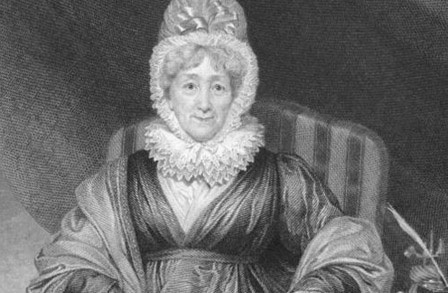 Hannah More, poet and abolitionist
Hannah More, poet and abolitionistIn 1802, Wilberforce engaged in other important issues of the day such as the Society for the Suppression of Vice, working with Hannah More and the Association for the Better Observance of Sunday, and also Royal Society for the Prevention of Cruelty to Animals. He also married and became the father of six children, to whom he was devoted. The abolition of slavery, however, was his life’s most important goal.
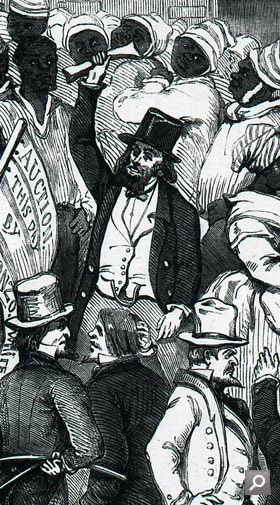 1833 Abolitionist Act succeeds in Britain
1833 Abolitionist Act succeeds in BritainIn 1807, the slave trade ended in England greatly because of Wilberforce’s work. Slavery, however, continued for those already enslaved in British colonies. All through the Regency, Wilberforce fought for the complete freedom of those enslaved.
In the early 1820s, he retired from politics due to poor health. He did not stop fighting for the abolition of slavery. Three days before he died in 1833, Parliament passed the act to abolition slavery in British colonies.
Originally posted 2013-07-29 03:21:02.
The post William Wilberforce: Abolitionist and Friend, Politician and Evangelical first appeared on Vanessa Riley's Regency Reflections.
June 30, 2024
How Louise M. Gouge Came To Write Regencies and a Giveaway!
Guest post by Louise M. Gouge
It all began with Jane
 Jane Austen
Jane AustenI have always loved stories set in the Regency period. One of my earliest movie memories is of watching Greer Garson and Laurence Olivier in the old black and white Pride and Prejudice. What a romantic story! I never even noticed that the costumes were definitely not from Jane Austen’s era. Later, I took a graduate class in Austen and loved reading all of her books. When the 1994 A & E version of Pride and Prejudice came on television, I was enthralled by the spectacular production. But I never considered writing a Regency romance because I wasn’t sure I could capture all the nuances of the era. There were just too many details I didn’t know about it.
Who, me?
But then I got tricked into it. I had just completed a Revolutionary War series and was wondering what to offer my editor in my next proposal. She solved my dilemma by asking me to write a Regency novella to be paired one by Deborah Hale, an experienced Regency author. I don’t know about you, but when my editor asks me to write a book, I say yes. The opportunity to share a book with Deb was icing on the cake.
So now I faced a challenge. As a reader, I don’t care much for careless or nonexistent research. As a writer, I endeavor to create interesting stories that take place in realistic settings. You may say, “Well, duh! Doesn’t every author want that?” But haven’t we all been pulled out of a story by some nagging little plot device we know could not have happened in that particular time period? Devoted Regency readers are particularly sensitive to such errors. I didn’t want that to happen with my story.
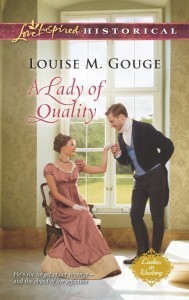 Louise’s latest Regency offering ~ proof that she mastered the genre.
Louise’s latest Regency offering ~ proof that she mastered the genre.Help arrives
Fortunately, I had the help of our good friend, Laurie Alice Eakes, an amazing author who knows the era well. She answered my pesky questions and insisted that I join the Beau Monde chapter of RWA. There I could ask the research mavens for help. And believe me, I did!
Well, I finished my novella, and by then I was hooked and ready to propose a full Regency series. After reading in another author’s lovely book that included a rather pathetic minor character who was a lady’s companion, I knew that had to be my subject. I came up with three different aristocratic young women who were forced by circumstances to go to work as companions. As you readers and writers of this era well know, it was shameful for aristocrats to work at any job, so my heroines were all bound to suffer Society’s disdain. Yet paired with the right hero, each lady found her true calling: marriage to the man of her dreams and a happily-ever-after life. So far, only a few tiny errors have crept into my books, but I welcome any corrections so I can get it right the next time.
Success!
By the way, that novella, The Gentleman Takes a Bride, earned second place in the Inspirational Readers Choice Awards, so I was more than pleased with that.
My brand new release, A Lady of Quality, is the third in my “Ladies in Waiting” series. Catherine Du Coeur is determined to uncover the truth about wealthy Lord Winston, who falsely accused her father of treason. But the closer she gets to the handsome young nobleman, the more she wonders how such a benevolent gentleman could have conspired to commit such evil. Baron Lord Winston has had little success in finding an accomplished aristocratic bride who is suited to his diplomatic aspirations. But when he meets Miss Du Coeur, a countess’s lowly companion, he finds that family connections are far less important than matters of the heart.
 Award-winning Florida author Louise M. Gouge writes historical fiction for Harlequin’s Love Inspired imprint. In addition to numerous other awards, Louise is the recipient of the prestigious Inspirational Readers’ Choice Award for her 2005 novel, Hannah Rose. With her great love of history and research, Louise has traveled to several of her locations to ensure the accuracy of her stories’ settings. When she isn’t writing, she and her husband love to visit historical sites and museums. Her 2011 Regency novella, The Gentleman Takes a Bride, earned second place in the prestigious Inspirational Readers Choice Award.
Award-winning Florida author Louise M. Gouge writes historical fiction for Harlequin’s Love Inspired imprint. In addition to numerous other awards, Louise is the recipient of the prestigious Inspirational Readers’ Choice Award for her 2005 novel, Hannah Rose. With her great love of history and research, Louise has traveled to several of her locations to ensure the accuracy of her stories’ settings. When she isn’t writing, she and her husband love to visit historical sites and museums. Her 2011 Regency novella, The Gentleman Takes a Bride, earned second place in the prestigious Inspirational Readers Choice Award.
One lucky commenter will win their choice of one of the Ladies In Waiting books. Leave a comment telling us why you started reading regencies to be entered to win!
Contest is now over. Look for Louise’s latest novel wherever you buy books.
Originally posted 2013-07-26 10:00:00.
The post How Louise M. Gouge Came To Write Regencies and a Giveaway! first appeared on Vanessa Riley's Regency Reflections.
I went to the Regency Ball and all I got…
Vanessa here,
I’m still in high cotton (Southern Phrase for High Ropes) and very tired after last week’s conference bonanza. I was privileged to attend the national conference for Romance Writers of America (RWA) and the conference of one its specialty chapters, the Beau Monde.
 Beau Monde Pin
Beau Monde PinThe Beau Monde chapter focuses on all things Regency. It was started in 1993 and attracts members worldwide. This year in lovely sweltering Atlanta the conference kicked off on Tuesday, July 16 (bag stuffing with tons of swag goodies) and then held a series of workshops on Wednesday, July 17.
I am always impressed by the caliber of the knowledge of the classes and these were no exception. From the Grand Tour with Regina Scott, Military History with Susanna Fraser, The Underworld with Erica Monroe, Playing Whist, and Regency Dancing, and so much more, I well pleased.
 Amy Pfaff, Candace Hern, Vanessa Riley enjoying a session.
Amy Pfaff, Candace Hern, Vanessa Riley enjoying a session.I bought the conference recordings. This much knowledge has to be replayed over and over again.
Now, I made a promise and a competition with my readers to choose the pattern and style of the Regency ball gown I would make for this conference. Begrudgingly, I stuck with it. I was able to finish it with a few hours to spare. Thank you for not choosing the harder pattern.
Before you ask: I used a sewing machine, I’m a Regency Chick not a masochist. While I did not use a zipper, a twentieth century tool may have been involved in closing the gown (Velcro – think lots of tiny hooks).
 Vanessa’s Finished Ball Gown of Grey Silk Taffeta
Vanessa’s Finished Ball Gown of Grey Silk TaffetaI have a lot of images and video of Regency dancing at the Soiree that I’m still sorting through but I thought I’d leave you with some images of the conference:
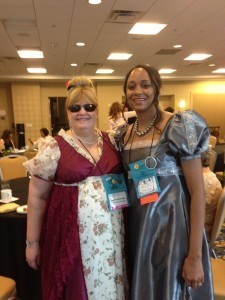 Laurie Alice Eakes in a burgundy and floral ball gown. We went to our book signings in these dresses.
Laurie Alice Eakes in a burgundy and floral ball gown. We went to our book signings in these dresses.
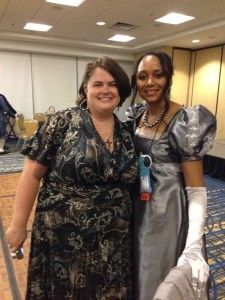 Kristi Hunter and I enjoying the music. Thanks for making me dance.
Kristi Hunter and I enjoying the music. Thanks for making me dance.
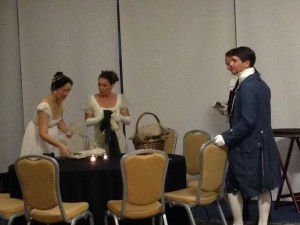 The professional Regency Dancers getting ready to teach the steps to the dances. Do they know what they are in for?
The professional Regency Dancers getting ready to teach the steps to the dances. Do they know what they are in for?
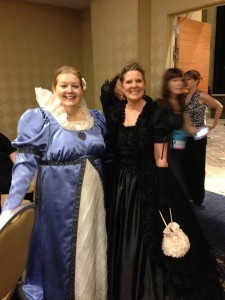 More Beau Monde Beauties
More Beau Monde Beauties
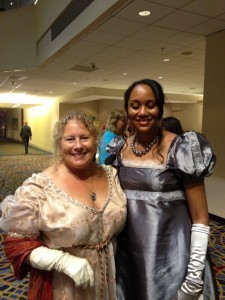 Ella Quin, one of the fabulous conference organizers.
Ella Quin, one of the fabulous conference organizers.
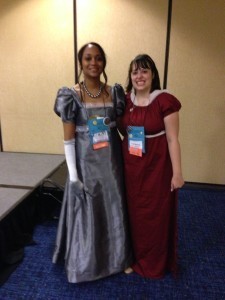 Erica Monroe and I took a turn about the hotel. Onlookers called us princesses. Didn’t have the heart to correct the titles.
Erica Monroe and I took a turn about the hotel. Onlookers called us princesses. Didn’t have the heart to correct the titles. 
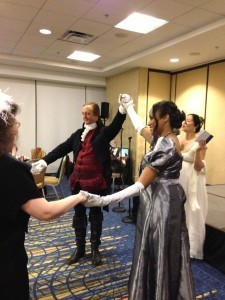 The dancing was quite strenuous and moved quickly. How did they have time to talk? How were they not winded?
The dancing was quite strenuous and moved quickly. How did they have time to talk? How were they not winded?I went to the Beau Monde and left with sore limbs and a bunch of new friends. Oh, and my dignity. The dress looked perfect and held together.
Be blessed.
Vanessa Riley is the author of Madeline’s Protector.
If all young men leapt off a cliff, Madeline St. James wouldn’t care. Yet a chance meeting and a bullet wound change everything. She must trust that the Good Shepherd has led her to marry a dashing stranger, Lord Devonshire. Can they forge a true bond before the next disaster strikes?See the trailer: https://www.youtube.com/watch?v=N2OnX... – See more at: http://www.christianregency.com
Originally posted 2013-07-24 10:00:00.
The post I went to the Regency Ball and all I got… first appeared on Vanessa Riley's Regency Reflections.
June 29, 2024
A Gentlewoman’s Guide to Opium Addiction ~ Guest Post by Michelle Griep
 A Gentlewoman’s Guide to Opium Addiction: How to Tell if Your Mr. Right Has Been Tokin’, Smokin’ or Shootin’ the Poppy ~ Guest Post by Michelle Griep
A Gentlewoman’s Guide to Opium Addiction: How to Tell if Your Mr. Right Has Been Tokin’, Smokin’ or Shootin’ the Poppy ~ Guest Post by Michelle GriepWhat comes to mind when I say Jane Austen? Hold on. Let me guess…
– swirling ballroom scenes
– dinner parties galore
– the dashing Mr. Darcy
Any of these answers would be right, of course, but you’d also be correct if you’d shouted out opium usage. Austen’s mother used opium to help her sleep, and her father was an agent in the trade. Elizabeth Barrett Browning took opiates every day from the age of fourteen, Sir Walter Scott consumed 6 grams a day, and Samuel Coleridge was a regular user.
Yes, indeed. I hate to burst your bubble of the romantic days of yore, but opium addiction was an issue to be reckoned with.
The first written account of the non-medicinal virtues of this drug is in De Quincey’s Confessions of an English Opium Eater, published in 1821. He advocates opium usage not as a pharmaceutical pain reliever but as a trip into “an inner world of secret self-consciousness.” Sounds positively hippyish, eh?
Had Mr. Darcy been hanging out in a nearby opium den, these are the symptoms Elizabeth Bennett should’ve looked for:
Red or glazed eyesConfusionSlurred or rapid speechLoss of appetiteApathy or depressionFrequent headachesInsomniaWhile Jane Austen preferred to write of dances and dinners, I dove into the seamier side of things and made the hero in A HEART DECEIVED a recovering opium addict. Why?
Because addiction is a contemporary problem with historical roots.
It’s just as hard for my fictional character Ethan to turn down a bottle of laudanum as it is for a real person today to pass on a hit of meth. With God’s help, it can be done—which is exactly what Ethan discovers.
So take care, gentlewomen, when searching out your Mr. Right. Opiates have been around since the days of Pharaoh, and are likely here to stay.
Interested in Ethan’s story? Check out A HEART DECEIVED…
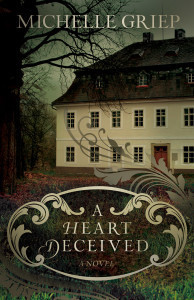 Miri Brayden teeters on a razor’s edge between placating and enraging her brother, whom she depends upon for support. Yet if his anger is unleashed, so is his madness. Miri must keep his descent into lunacy a secret, or he’ll be committed to an asylum—and she’ll be sent to the poorhouse.
Miri Brayden teeters on a razor’s edge between placating and enraging her brother, whom she depends upon for support. Yet if his anger is unleashed, so is his madness. Miri must keep his descent into lunacy a secret, or he’ll be committed to an asylum—and she’ll be sent to the poorhouse.
Ethan Goodwin has been on the run all of his life—from family, from the law … from God. After a heart-changing encounter with the gritty Reverend John Newton, Ethan would like nothing more than to become a man of integrity—an impossible feat for an opium addict charged with murder.
When Ethan shows up on Miri’s doorstep, her balancing act falls to pieces. Both Ethan and Miri are caught in a web of lies and deceit—fallacies that land Ethan in prison and Miri in the asylum with her brother. Only the truth will set them free.
A HEART DECEIVED is available by David C. Cook and at Amazon, Barnes & Noble, and ChristianBook.
Keep up with the exploits of Michelle Griep at Writer Off the Leash, Facebook, Twitter, and Pinterest.
Originally posted 2013-07-22 10:00:00.
The post A Gentlewoman’s Guide to Opium Addiction ~ Guest Post by Michelle Griep first appeared on Vanessa Riley's Regency Reflections.
British Rights: Habeas Corpus and the Bill of Rights
On Wednesday, we started looking at the different rights that Regency Era subjects had in relation to their government. We talked specifically about the Magna Carta and Petition of Right of 1628. Today we’re going to continue that discussion and further analyze what protections, if any, the people of Regency England had from their king and his government.
Habeas Corpus
Habeas Corpus is the next major political document that further helped protect the British. If you recall, the Petition of Right declared that a British subject living in England could not be “detained or imprisoned without cause.” While that in and of itself is an excellent protection, it left the actual aspect of imprisonment free for abuse. Say the government had a cause to imprison you. Great. (Well, not really, but it works for our purposes). So you get thrown into prison because you were suspected of stealing a loaf of bread or some such. How long until you appear before a magistrate or a jury of your peers?
Possibly never. Because while the Petition of Right protected you from being wrongfully imprisoned, it didn’t guarantee you a trial. Habeas Corpus guarantees that a person can be take before a court if they so wish.
So did Habeas Corpus protect the average English man and woman? Definitely! In fact, most countries today have their own form of Habeas Corpus (which is still very much alive in the United Kingdom as well).
Bill of Rights
Our last piece of legislation to look at is the Bill of Rights of 1689 (and yes, this is different from the Bill of Rights in the U.S. Constitution). This bill limited the power of English sovereigns by guaranteeing the king or queen could not:
Interfere with the law.Establish a tax by him or herself and without an act of Parliament.Maintain a standing army during peace times.Limit firearms for citizens.Interfere in parliamentary elections.Question the freedom of speech used in parliament.Use excessive bail or cruel and unusual punishment.So yes, the Bill of Rights did protect your average Regency subject, and furthermore, the Bill of Rights of 1689 has been considered a forerunner of similar documents in France, the United States, Canada, the United Nations, and the European Union.
Evidently the British hit on something very important when they came up with the first ever Bill of Rights. I’m certainly glad that people during the Regency Era were afforded such protections. At the same time, my heart goes out the the French and American people for having to fight so hard to secure similar freedoms for themselves in the century that followed.
Okay, thank you for joining me as we explored British rights for the past two day. I certainly hope you enjoyed the discussion.
Originally posted 2013-07-19 10:00:54.
The post British Rights: Habeas Corpus and the Bill of Rights first appeared on Vanessa Riley's Regency Reflections.
June 28, 2024
British Rights: What Protected Regency Subjects from the Government?
Hi Everyone,
It’s July, and with this month every summer comes national celebratory days in several countries. Canada celebrates Canada Day on July 1. The United States celebrates their Independence Day on July 4. And France celebrated its Bastille Day earlier this week on July 14. So all the celebrations of the past few weeks (as well as some research I’ve been doing on the Napoleonic Wars) led me to ask a few questions about our Regency men and women.
The Americans had their Constitution and Bill of Rights by this point, and the French had their Declaration of the Rights of Man as well as Napoleon’s Civil Code to help protect its citizens from the government. But did England have anything? If so, what? The entire social class structure that so dominated the Regency Era has never really struck me as fair or liberating, nor does the concept of a hereditary monarchy and peerage. So I did some homework, and it turns out England did indeed have civil rights protection for it’s subjects during the Regency Era (at least those subjects residing in England itself). In fact, England was really one of the first countries to start implementing these protections. We’re going to spend both today and Friday looking at them.
Magna Carta
The first of these documents is the Magna Carta, signed by King John of England on June 15, 1215. The Magna Carta established rights of English barons and large land owners–rights that the king could not take away for any reason. In so doing, the Magna Carta also limited the power of the king. It is almost a prophetical document of the constitutional monarchy that was to come in the 1600s, and is known for “bringing the king under the law.”
So did the Magna Carta protect the every day commoner? The short answer is “No, it did not.” It protected the already wealthy and powerful from the more wealthy and more powerful king. But it was a start, a very good start, at recognizing the innate value of each and every human being, not just the king.
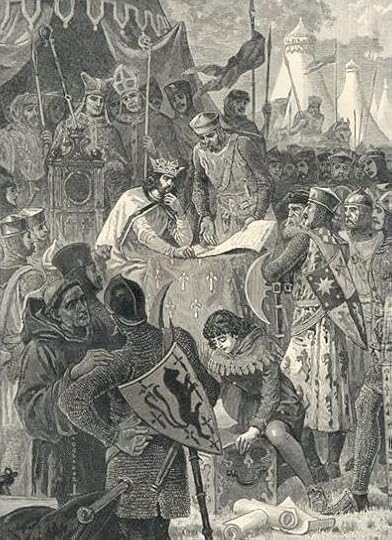
Petition of Right of 1628
The next major political act protecting the rights of men and women was the Petition of Right of 1628. This document delineates certain liberties that the king could not infringe upon. It says no person would be:
Forced to provide a gift, loan, or tax without an act of Parliament.Detained and imprisoned without cause.Forced to house soldiers or members of the navy.Made subject to martial law unless under circumstances of war or direct rebellion.This petition was passed by Parliament in 1628 and then again in 1641, though it still had a rather rough road ahead of it and would eventually be one of the causes of the English Civil War. But it was a start in affording the common citizen with liberties. And unlike the Magna Carta, the Petition of Right protected the common Englishman and Englishwoman.
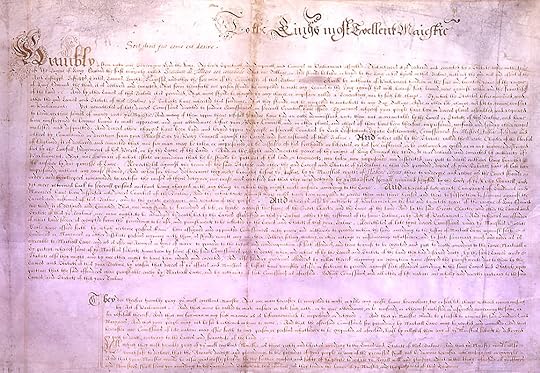
The more I study British history, the more I see how its ruling class took actions to protect the lower classes earlier in history that the rest of the world. Did England have a ruling class that often took advantage of the lower classes? Certainly. But at the same time, the British peerage didn’t shamelessly use the commoner the way the French aristocracy and monarchy did the peasant. They didn’t even extort the average commoner the way they did the colonists across the Atlantic Ocean.
Do any of the rights mentioned above surprise you? I was a little shocked–not that the rights existed, but that some of them existed so early. Do you feel one of the rights delineated above stands out above the others and is more important in some way? I’d love to hear which one and why in the comments below.
And don’t forget, I’ll be back on Friday to finish this discussion.
Originally posted 2013-07-17 10:00:59.
The post British Rights: What Protected Regency Subjects from the Government? first appeared on Vanessa Riley's Regency Reflections.

